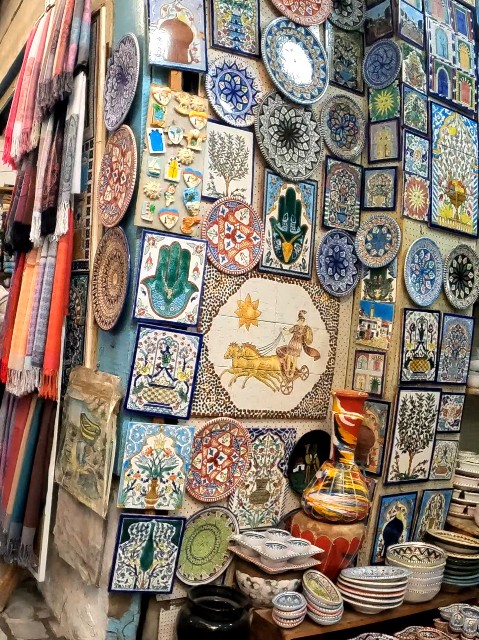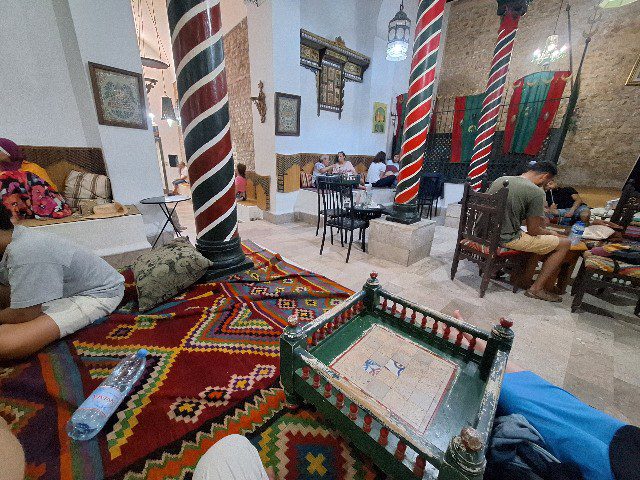
https://emojiterra.com/hamsa/
When browsing X (formerly Twitter) or Instagram, you might occasionally notice a strange emoji “🪬“. This symbol, which appears to be a blue palm with an eye-like design in the center, might seem eerie at first glance. Its design is reminiscent of the Freemason symbol “The Eye of Providence,” though they are distinctly different. In fact, this symbol has a profound meaning and is a traditional amulet called the “Hamsa” that has been cherished in the Middle East for centuries. The mysterious hand shape that has suddenly appeared in our daily lives actually carries thousands of years of history and deep meaning. Today, I’ll explain the Hamsa from the perspective of a Middle Eastern travel enthusiast.
What is a Hamsa?

“Hamsa”, meaning “five” in Arabic, is a symbol representing a palm with five fingers. Its shape is basically that of an outstretched human right hand, with an eye motif placed in the center of the palm. Sometimes it may include depictions of fish or other lucky symbols.
A distinctive feature of this amulet is that it can be used facing either upward or downward. When facing upward, it’s said to attract active good fortune, while facing downward, it acts more strongly as a protective talisman. The spread-finger shape is also believed to hold the power to ward off evil.

The Hamsa is widely used as an architectural motif throughout the Middle East, including Tunisia
Ancient History Spread Throughout the Mediterranean

The North African region centered around Carthage, which had active exchange (and warfare) with ancient Rome
The history of the Hamsa dates back to the ancient Mediterranean world. In ancient Phoenicia, hand patterns were used as symbols of Tanit, the goddess of fertility and war. Similar hand symbols were also seen in festivals for the ancient Greek god Bacchus, and were later inherited into the worship of Juno in ancient Rome.
The Hamsa has thus been cherished in various cultures along the Mediterranean coast throughout history. Gradually changing its form over time, it has been carefully passed down to the present day as a symbol for “protection” and “abundance.”
Protection from the Evil Eye – An Eye for an Eye
The evil eye refers to the “malevolent power” that resides in jealous or ill-intentioned gazes. Perhaps everyone has experienced being “envied by someone” or “looked at with malicious intent.” In particular, it’s not uncommon for those who have achieved success or happiness to be exposed to envious gazes from others.
People in the Middle East have traditionally believed that the evil eye has the power to cause actual harm. For instance, sudden illness, misfortune, or business failures were also thought to be influenced by the evil eye. In particular, young children, pregnant women, newlyweds, and those starting new businesses were considered especially vulnerable to the evil eye’s influence, requiring special protection.
The “eye” depicted in the center of the Hamsa exists precisely to protect against this evil eye. With the concept of “an eye for an eye,” it is believed to have the power to repel malicious gazes. This eye is thought to function as a constant lookout, continuing to watch over its owner.
Similarities with Turkey’s Blue Eye “Nazar Boncuğu”

Speaking of evil eye protection, Turkey’s “Nazar Boncuğu” is also famous. It’s an amulet in the form of a blue eye, and like the Hamsa, it’s said to protect against the evil eye. In the Middle East region, the concept of repelling the evil eye using “eye” motifs is widely shared.
Both the Nazar Boncuğu and the Hamsa are deeply rooted in their regional cultures, and can still be seen in various places today – in homes, shops, inside cars, and more. These amulets are closely connected to the lives of the people in these regions.
A Symbol of Protection Adorned in Blue
The Hamsa is often colored blue, which is not a coincidence. In North African countries, including Tunisia, blue is a color deeply rooted in daily life. It is used in cityscapes, everyday items, decorations, and many other places. For more on the cultural meaning and history of blue in this region, please refer to our past article.
Modern Hamsa Culture – From My Experiences in Tunisia
When I actually visited Tunisia, I was surprised by the significant presence of the Hamsa. In the old town Medina of the capital Tunis, I often saw blue doors of traditional houses decorated with Hamsa designs.

Particularly impressive was the scene at the souvenir shops in the Medina. Hamsa-shaped charms and colorful tiles were displayed in abundance, with a wide variety of designs from modern to traditional. There was a rich assortment, including those made of ceramics, brass, and even modern resin accessories.
One shopkeeper told me, “The Hamsa is not just an amulet.” His words, “This is our culture and an important wisdom inherited from our ancestors,” left a deep impression on me.
The Global Appeal of the Hamsa
In recent years, the Hamsa has gained popularity beyond the Middle East region, attracting attention worldwide. In addition to being incorporated into emojis recently, it has also gained attention as a fashion accessory, being incorporated into various items such as necklaces, earrings, and bracelets as a design element. The reason for its popularity may be not only its unique beauty but also the universal wish to protect oneself from the evil eye.
Conclusion
The Hamsa, which at first glance combines eeriness and mysticism, is more than just an amulet. It is a symbol that condenses people’s wishes, prayers, and cultural identity.
Behind the emoji you see on social media exists such a deep cultural background. Though it may look strange, its essence contains wishes for people’s happiness. The next time you see a Hamsa, please remember this background.





